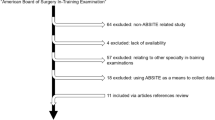Abstract
Purpose
The European Board of Paediatric Surgery (EBPS) includes a written Part 1 and an oral/practical Part 2 component. The goal of this study was to describe the EBPS examination candidate pool, and to determine factors associated with successfully passing the examination.
Methods
A database including all registered candidates for the EBPS exams since 2005 was constructed. Queried information included demographics, training location, language proficiency, and written/oral scores. Logistic regression analysis was performed to elucidate variables predictive of examination success.
Results
Until 2013, a total of 370 candidates registered for the part 1 examination and 147 successfully passed part 2. Pass rates for part 1 were 68, 65, 20, and 0 % on first, second, third, and forth attempts, respectively. Pass rates for part 2 were 79 % for both first and second attempts. Training in a single country was associated with passing Part 1 (p = 0.048), while having completed at least some training in an English-speaking country increased the chance of passing Part 2 (p < 0.01).
Conclusion
The pool of EBPS examination candidates is highly diverse and international. First- and second-attempt pass rates are similar for both parts. Candidates who completed all their training in non-English-speaking countries may wish to consider additional English language practice to increase their chances of success.



Similar content being viewed by others
References
Carachi R (2001) President’s report of the european board of paediatric surgery (EBPS). Eur J Pediatr Surg 11:285–287
EBPS (2015) Format and scope of the examination. http://www.paediatricsurgeryexam.org/index.php?option=com_content&view=article&id=29&Itemid=133. Accessed 2 Mar 2015
UEMS (2015) Training requirements for the specialty of paediatric surgery. European standards of postgraduate medical specialist training. http://www.uems.eu/__data/assets/pdf_file/0018/7551/Item-5.3.2-Training-requirements-pediatric-surgery-feb2014-for-endorsement.pdf. Accessed 2 Mar 2015
EBPS (2015) EBPS examiners. http://www.paediatricsurgeryexam.org/index.php?option=com_zoo&view=category&layout=category&Itemid=209. Accessed 2 Mar 2015
The American Board of Surgery (2015) Diplomate totals. http://www.absurgery.org/default.jsp?statsummary. Accessed 2 Mar 2015
Darves B (2015) Physician shortages in the specialties taking a toll. http://www.nejmcareercenter.org/article/physician-shortages-in-the-specialties-taking-a-toll/. Accessed 2 Mar 2015
Nakayama DK, Burd RS, Newman KD (2009) Pediatric surgery workforce: supply and demand. J Pediatr Surg 44:1677–1682
Mshelbwala PM, Nwomeh BC (2015) Paediatric surgery specialty and its relevance to Africa. http://www.global-help.org/publications/books/help_pedsurgeryafrica01.pdf. Accessed 2 Mar 2015
Author information
Authors and Affiliations
Corresponding author
Rights and permissions
About this article
Cite this article
Muensterer, O.J., Bronstein, M.E., Mackenzie, R. et al. Factors associated with passing the European Board of Paediatric Surgery Exam. Pediatr Surg Int 31, 671–676 (2015). https://doi.org/10.1007/s00383-015-3719-7
Accepted:
Published:
Issue Date:
DOI: https://doi.org/10.1007/s00383-015-3719-7




